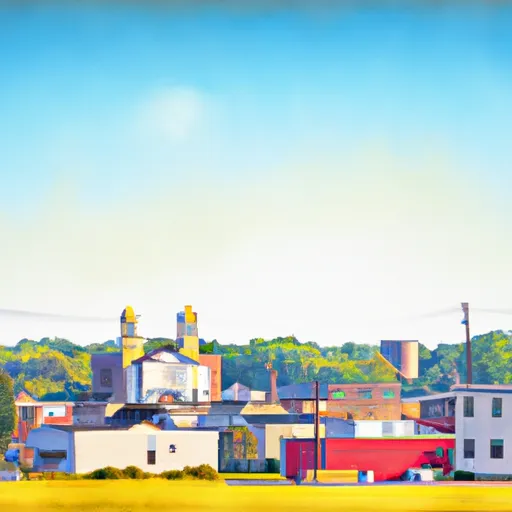-
 Snoflo Premium
Snoflo Premium
Get unlimited access to all our content
With no Ad interruptions! - Start Your Free Trial Login with existing account
Mooreland
Eden Index
Climate
7.8
•
Recreation
2.8
•
Community
•
Safeguard
4.1/10

Mooreland, Indiana is a small town located in Henry County, in the central part of the state. The climate in Mooreland is classified as humid continental, with hot summers and cold winters. Average temperatures range from highs of around 85°F (29°C) in summer to lows of about 20°F (-6°C) in winter.
Hydrology constituents in Mooreland are primarily influenced by the nearby West Fork of the White River, which runs through the town. This river not only provides a scenic landscape but also offers recreational opportunities such as fishing and boating. The water quality is generally good, with efforts made to maintain a healthy ecosystem for aquatic life.
Outdoor recreation enthusiasts in Mooreland can enjoy various activities, including hiking, camping, and birdwatching. The town is surrounded by lush forests and natural areas, providing ample opportunities for exploration and enjoying nature. Nearby Prairie Creek Reservoir offers additional opportunities for boating, fishing, and swimming.
In summary, Mooreland, Indiana offers a pleasant climate with distinct seasons, a local river providing hydrological benefits, and a range of outdoor recreation opportunities that cater to nature lovers and adventure seekers alike.
What is the Eden Index?
The Snoflo Eden Index serves as a comprehensive rating system for regions, evaluating their desirability through a holistic assessment of climate health, outdoor recreation opportunities, and natural disaster risk, acknowledging the profound impact of these factors on livability and well-being.
Climate Health Indicator (CHI): 7.8
Mooreland receives approximately
1059mm of rain per year,
with humidity levels near 83%
and air temperatures averaging around
10°C.
Mooreland has a plant hardyness factor of
5, meaning
plants and agriculture in this region thrive during a short period during spring and early summer. Most
plants will die off during the colder winter months.
By considering the ideal temperature range, reliable water supplies, clean air, and stable seasonal rain or snowpacks, the Climate Health Indicator (CHI) underscores the significance of a healthy climate as the foundation for quality living.
A healthy climate is paramount for ensuring a high quality of life and livability in a region, fostering both physical well-being and environmental harmony. This can be characterized by ideal temperatures, reliable access to water supplies, clean air, and consistent seasonal rain or snowpacks.
Weather Forecast
Streamflow Conditions
Patoka-White
Area Rivers
Patoka-White
Snowpack Depths
Patoka-White
Reservoir Storage Capacity
Patoka-White
Groundwater Levels
Recreational Opportunity Index (ROI): 2.8
The Recreational Opportunity Index (ROI) recognizes the value of outdoor recreational options, such as parks, hiking trails, camping sites, and fishing spots, while acknowledging that climate plays a pivotal role in ensuring the comfort and consistency of these experiences.
Access to outdoor recreational opportunities, encompassing activities such as parks, hiking, camping, and fishing, is crucial for overall well-being, and the climate plays a pivotal role in enabling and enhancing these experiences, ensuring that individuals can engage in nature-based activities comfortably and consistently.
Camping Areas
| Campground | Campsites | Reservations | Toilets | Showers | Elevation |
|---|---|---|---|---|---|
| Taylorsville Lake State Park | 40 | 760 ft | |||
| Guist Creek Lake County Park | None | 792 ft | |||
| Lake Jericho Recreation Area | 62 | 814 ft | |||
| General Butler State Park | 110 | 490 ft | |||
| My Old Kentucky Home State Park | 40 | 668 ft | |||
| Versailles State Park | 225 | 965 ft | |||
| Lake Shelby Campground | 20 | 721 ft | |||
| Madison City Park | 35 | 450 ft | |||
| Paul Ogle Riverfront Park | None | 451 ft | |||
| Clifty Falls State Park | 165 | 843 ft |
Nearby Ski Areas
Catastrophe Safeguard Index (CSI):
The Catastrophe Safeguard Index (CSI) recognizes that natural disaster risk, encompassing floods, fires, hurricanes, and tornadoes, can drastically affect safety and the overall appeal of an area.
The level of natural disaster risk in a region significantly affects safety and the overall livability, with climate change amplifying these risks by potentially increasing the frequency and intensity of events like floods, fires, hurricanes, and tornadoes, thereby posing substantial challenges to community resilience and well-being.
Community Resilience Indicator (CRI):
The Community Resilience Indicator (CRI) recognizes that education, healthcare, and socioeconomics are crucial to the well-being of a region. The CRI acknowledges the profound impact of these elements on residents' overall quality of life. By evaluating educational resources, healthcare accessibility, and economic inclusivity, the index captures the essential aspects that contribute to a thriving community, fostering resident satisfaction, equity, and social cohesion.

